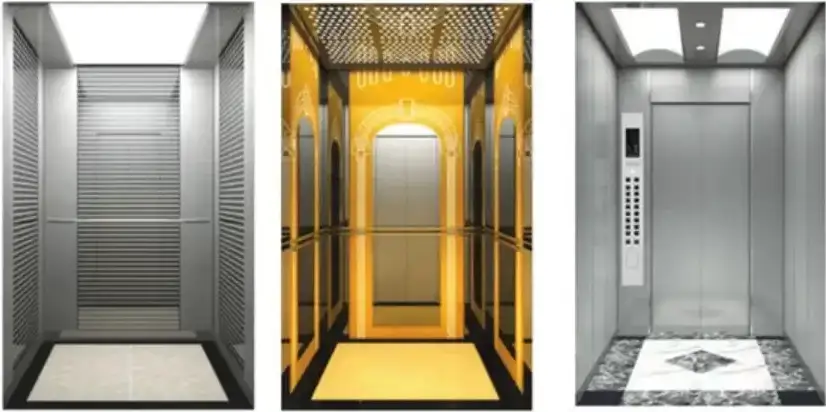Welcome to our comprehensive guide on passenger elevators! Whether designing a new building or considering an upgrade, understanding the different types and features of passenger elevators is crucial. These vertical transportation systems not only provide convenience but also enhance the overall functionality and accessibility of a building.
Types of Passenger Elevators:
When it comes to passenger elevators, there are primarily two types that dominate the market: hydraulic elevators and traction elevators. Let’s look at each type and what sets them apart.
Hydraulic elevators
Hydraulic elevators are among the most common passenger elevators in buildings today. These elevators use a hydraulic system to move the elevator car between floors. The basic principle behind hydraulic elevators is simple yet effective. A piston at the elevator shaft’s bottom pushes oil or another fluid into a cylinder, causing it to rise and lift the elevator car. When the desired floor is reached, valves release the pressure, allowing the vehicle to lower back down.
Traction elevators
One key advantage of traction elevators is their smooth and quiet operation. The electric motor provides a more controlled movement, allowing for a comfortable ride experience. Additionally, traction elevators can reach higher speeds than hydraulic elevators, making them ideal for tall buildings with high traffic volumes. Another benefit of traction elevators is their energy efficiency. Using electric motors means that these elevators consume less power than hydraulic systems. This not only reduces operating costs but also makes them more environmentally friendly.
Features and Benefits of Modern Passenger Elevators:
Modern passenger elevators have various features and benefits that prioritize safety, convenience, and energy efficiency. These advancements have revolutionized vertical transportation in buildings across the globe. Safety is paramount when it comes to passenger elevators. Modern systems are designed with multiple safety features to ensure smooth operation and protect passengers from potential hazards. Emergency communication systems, fire-rated doors, and automatic rescue devices are some measures taken to enhance passenger safety.
Safety features
Passenger elevators have come a long way in terms of safety features. These modern marvels are designed to ensure the well-being and security of everyone who steps foot inside them. From sophisticated sensors to emergency communication systems, here are some key safety features for choosing a passenger elevator. One important safety feature is the presence of door sensors. These sensors detect obstructions near the doors, preventing them from closing on someone or something.
Energy efficiency
Energy efficiency is a crucial factor to consider when choosing a passenger elevator for your building. Energy-efficient elevators have become increasingly popular with the increasing focus on sustainability and reducing carbon footprints. Modern passenger elevators are designed with advanced technologies that optimize energy consumption without compromising performance.
Factors to Consider When Choosing a Passenger Elevator:
1. Building requirements: The first and foremost factor to consider when choosing a passenger elevator is the specific requirements of your building. Factors such as the number of floors, available space for installation, and weight capacity should be considered. Ensuring that the elevator you choose meets all the necessary building codes and regulations is essential.
2. Traffic flow analysis: Understanding the traffic flow in your building is crucial in determining the correct type of passenger elevator. Analyzing peak hours, number of users, and destinations can help determine factors like speed, capacity, and design features required for efficient transportation within your building.
3. Safety features: Safety should always be a top priority when selecting a passenger elevator. Look for elevators with advanced safety features such as emergency stop buttons, CCTV surveillance systems, fire-resistant materials, and automatic rescue devices to evacuate passengers during emergencies safely.
4. Energy efficiency: In today’s world, where sustainability matters more than ever, choosing an energy-efficient passenger elevator system is essential. Look for elevators with regenerative drives that convert excess power into usable electricity or LED lighting systems that reduce energy consumption without compromising brightness.
5. Installation and maintenance: Before deciding which passenger elevator to install in your building, consider factors like ease of installation and maintenance requirements. Opting for elevators from reputable manufacturers who offer reliable after-sales support will ensure smooth operation and minimize downtime due to potential issues or repairs.
Building requirements
One of the crucial factors to consider is the building requirements. Every building has unique specifications and needs, which must be considered during the elevator selection process. You need to assess the size and layout of your building. This includes analyzing factors such as the number of floors, available space for installation, and any architectural constraints that may impact elevator placement. You should consider the weight capacity required for your building.
Traffic flow analysis
Traffic flow analysis is a crucial factor to consider when choosing a passenger elevator for your building. Understanding the patterns and volume of foot traffic in your building will help determine the size, speed, and number of elevators needed to transport passengers efficiently. By conducting a comprehensive traffic flow analysis, you can identify peak hours and areas of high congestion within your building. This information lets you strategically place elevators in critical locations to minimize wait times and maximize efficiency. Analyzing the traffic flow also helps determine the capacity required for each elevator. Considering factors such as average occupancy per floor, travel distance, and time constraints during peak hours, you can ensure that your elevators can handle the expected passenger demand without overcrowding or delays.
Installation and Maintenance of Passenger Elevators:
After carefully considering the types, features, and factors when choosing a passenger elevator, it is essential to touch upon the crucial aspects of installation and maintenance. The successful installation and ongoing maintenance of passenger elevators are vital for their smooth operation and longevity. It is imperative to work with experienced professionals with expertise in elevator installations during the installation process. They will ensure that all safety regulations are followed, proper wiring is done, and necessary inspections are carried out. A well-executed installation ensures that the elevator functions optimally from day one.





